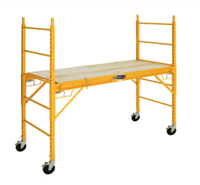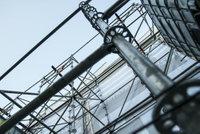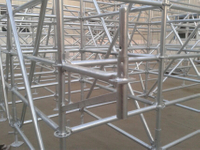Content Menu
● Introduction to Tube and Coupler Scaffolding
● Components of Tube and Coupler Scaffolding
>> Scaffold Tubes
>> Couplers
● Assembly Process
● Safety Considerations
● Best Practices
● Advanced Techniques for Complex Projects
● Environmental Considerations
● Legal and Regulatory Compliance
● Conclusion
● FAQ
>> 1. What are the main components of tube and coupler scaffolding?
>> 2. How do I ensure the stability of the scaffold?
>> 3. What safety measures should I take when assembling scaffolding?
>> 4. Can tube and coupler scaffolding be customized for complex projects?
>> 5. What are the benefits of using tube and coupler scaffolding?
● Citations:
Tube and coupler scaffolding is a versatile and widely used system in construction projects due to its strength, durability, and adaptability. It consists of steel tubes and various types of couplers that connect these tubes to form a stable structure. This article will guide you through the process of assembling tube and coupler scaffolding, highlighting key components, safety considerations, and best practices.
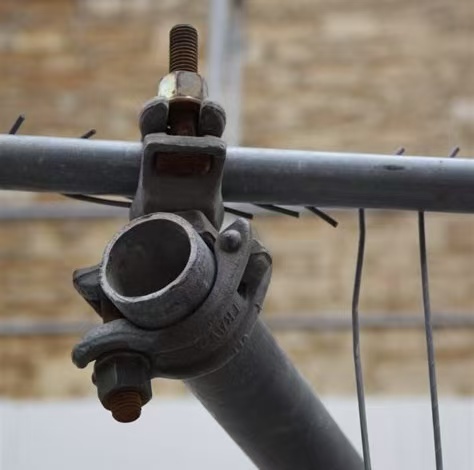
Introduction to Tube and Coupler Scaffolding
Tube and coupler scaffolding is designed to provide a safe and efficient working platform for construction workers. The system includes:
- Scaffold Tubes: These are the primary structural components, available in various lengths and diameters.
- Couplers: These are fittings used to connect the tubes. Common types include right angle, swivel, sleeve, board retaining, and base plate couplers.
Components of Tube and Coupler Scaffolding
Scaffold Tubes
Scaffold tubes are typically made of steel and come in different lengths, ranging from a few feet to over 20 feet. They are used both vertically and horizontally to form the framework of the scaffold.
Couplers
Couplers are essential for connecting the tubes securely. The main types include:
- Right Angle Couplers: Used to connect tubes at 90-degree angles, forming frames and supports.
- Swivel Couplers: Allow tubes to be connected at various angles, often used for diagonal bracing.
- Sleeve Couplers: Join tubes end-to-end, extending the length of scaffold runs.
- Board Retaining Couplers: Secure scaffolding boards in place.
- Base Plate Couplers: Provide a stable base for the scaffold.
| Type of Coupler | Function | Application in Scaffolding |
| Right Angle Couplers | Secure tubes at 90 degrees | Creating right angles for frames and supports |
| Swivel Couplers | Connect tubes at various angles | Supporting diagonal bracing in scaffolds |
| Sleeve Couplers | Join scaffold tubes end-to-end | Extending the length of scaffold runs |
| Board Retaining Couplers | Secure scaffolding boards in place | Preventing movement of platforms |
| Base Plate Couplers | Provide a flat bearing surface | Stabilizing scaffolds at the base |
Assembly Process
Assembling tube and coupler scaffolding requires careful planning and execution to ensure safety and stability.
1. Preparation:
- Site Inspection: Ensure the ground is level and firm. This step is crucial to prevent the scaffold from tilting or collapsing.
- Tools and Materials: Gather all necessary tubes, couplers, and tools. Ensure that all components are in good condition and suitable for the task.
2. Base Assembly:
- Place base plates on the ground to distribute the weight evenly. This helps prevent sinking into soft ground and ensures stability.
- Attach vertical tubes (standards) to the base plates using base plate couplers. Make sure these connections are secure and tightened properly.
3. Frame Construction:
- Use right angle couplers to connect horizontal tubes (ledgers) to the standards. This forms the basic frame of the scaffold.
- Install intermediate standards if necessary for added support. These are particularly useful for longer scaffolds or those carrying heavy loads.
4. Platform Installation:
- Lay scaffolding boards across the ledgers. Ensure these boards are securely fastened to prevent movement.
- Secure boards with board retaining couplers. This step is critical for preventing accidents caused by loose boards.
5. Bracing:
- Install diagonal bracing using swivel couplers for added stability. Diagonal bracing helps prevent the scaffold from swaying in the wind.
- Ensure bracing is at a 45-degree angle. This angle provides optimal support and stability.
6. Final Checks:
- Verify all connections are secure. Double-check that all couplers are tightened properly.
- Ensure the scaffold is level and plumb. Use a spirit level to confirm the scaffold's stability.
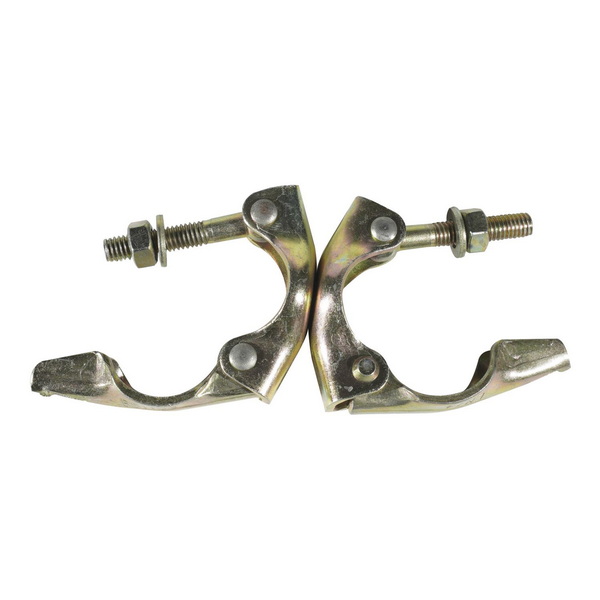
Safety Considerations
Safety is paramount when assembling scaffolding. Always follow these guidelines:
- Training: Ensure all personnel are trained in scaffold assembly and safety. Proper training reduces the risk of accidents.
- Inspection: Regularly inspect the scaffold for damage or wear. Check for rust, bent tubes, or loose connections.
- Load Capacity: Never exceed the recommended load capacity. Overloading can lead to structural failure.
- Fall Protection: Use safety harnesses and guardrails as necessary. These prevent falls from heights and protect workers.
Best Practices
- Plan Ahead: Design the scaffold layout according to the project's needs. Consider the height, width, and any obstacles.
- Use Proper Tools: Always use the correct tools for tightening couplers. Avoid using makeshift tools that could damage the couplers.
- Regular Maintenance: Regularly check and maintain the scaffold. This includes cleaning, lubricating moving parts, and replacing worn components.
Advanced Techniques for Complex Projects
For more complex projects, tube and coupler scaffolding can be customized to fit unique building shapes or requirements. This includes:
- Curved Scaffolds: Using swivel couplers to create curved sections for irregularly shaped buildings.
- Multi-Level Scaffolds: Building multiple levels of scaffolding to access different parts of a structure.
- Bridge Scaffolds: Spanning scaffolds across gaps or voids to provide continuous access.
Environmental Considerations
When assembling scaffolding, consider environmental factors:
- Weather Conditions: Avoid assembling scaffolds during strong winds or heavy rain. These conditions can compromise stability.
- Ground Conditions: Ensure the ground is firm and level. Soft or uneven ground can lead to instability.
Legal and Regulatory Compliance
Ensure that all scaffolding assembly complies with local and national regulations. This includes adhering to safety standards and obtaining necessary permits.
Conclusion
Tube and coupler scaffolding offers a reliable and adaptable solution for construction projects. By understanding the components, assembly process, and safety considerations, you can ensure a safe and efficient working environment. Always follow best practices and consult professionals if unsure about any aspect of scaffold assembly.
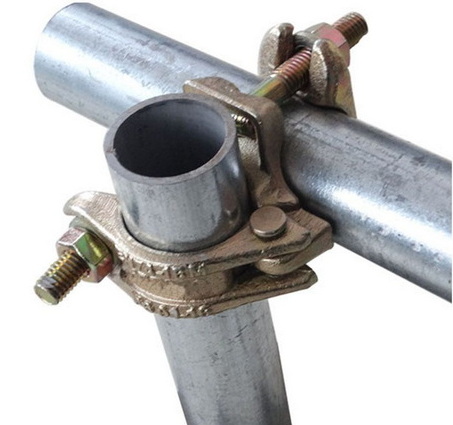
FAQ
1. What are the main components of tube and coupler scaffolding?
Tube and coupler scaffolding consists of steel tubes and various types of couplers, including right angle, swivel, sleeve, board retaining, and base plate couplers.
2. How do I ensure the stability of the scaffold?
Stability is achieved by using proper bracing, ensuring all connections are secure, and maintaining a level base. Regular inspections are also crucial.
3. What safety measures should I take when assembling scaffolding?
Always wear safety gear, ensure proper training, and never exceed the load capacity. Regularly inspect the scaffold for damage.
4. Can tube and coupler scaffolding be customized for complex projects?
Yes, the system is highly adaptable. Tubes and couplers can be arranged to fit irregular building shapes, making it suitable for a variety of construction projects.
5. What are the benefits of using tube and coupler scaffolding?
The benefits include strength, durability, versatility, and the ability to customize the scaffold to fit specific project needs. It is widely used in building construction, bridge construction, and industrial maintenance.
Citations:
[1] https://www.youtube.com/watch?v=ZM6Tlh_NAnQ
[2] https://www.youtube.com/watch?v=RCdHJ2Dkjfg
[3] https://patents.google.com/patent/CN101053134B/zh
[4] https://scaffoldtype.com/tube-and-coupler-scaffolding/
[5] https://www.youtube.com/watch?v=a5VG7k_boDs
[6] https://patents.google.com/patent/CN211693891U/en
[7] https://www.osha.gov/sites/default/files/publications/OSHA_FS-3759.pdf
[8] https://www.youtube.com/watch?v=irTZ0ANFaUM













